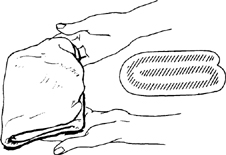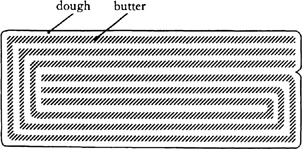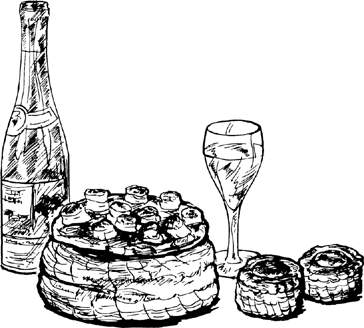Mastering the Art of French Cooking, Volume 2 (56 page)
Read Mastering the Art of French Cooking, Volume 2 Online
Authors: Julia Child

Place dough in front of you so that top flap is to your right, as though it were a book |
|
| Roll again into a 16-inch rectangle and again fold in three, |
Wrap dough in waxed paper and slip it into a plastic bag. Refrigerate for 40 to 60 minutes to relax the gluten and to firm butter for next turns, which it is best to complete within an hour if you can so that layers of butter do not become too firm and congealed.
5)
Turns 3 and 4—after a rest of 40 to 60 minutes
If dough is hard and cold, beat with firm even strokes to soften butter. Complete Turns 3 and 4 in the same way as the previous turns. You may find during the rolling out that the bottom layer of dough does not stretch out to meet the top and middle layers at each end: turn dough over and roll upside down to even the layers. Make 4 depression marks in the dough to indicate the 4 turns; wrap and chill again for at least an hour before starting Turns 5 and 6.
(*)
DELAYED-ACTION NOTE
: This is the best point to refrigerate the dough for several days, or to freeze it for several months.
6)
Turns 5 and 6—after a rest of at least 1 hour, and 2 hours before you wish to form and bake the dough
Complete Turns 5 and 6 in the same manner. (It is here that if you have given the dough only its minimum rest period you may find it hard to roll out and inclined to retract rather severely when extended. If this happens, stop immediately; forcing it will only make the gluten more tenacious and the dough more balky. Wrap and refrigerate the dough for an hour more before continuing.) Make 3 pairs of depression marks in the top of the dough to indicate the 6 turns. Wrap and refrigerate for 2 hours before forming and baking.
(*)
DELAYED-ACTION NOTES
: When you are making the dough for a
vol-au-vent
, you will usually get the highest rise when you form and bake the dough about 2 hours after the final turn. For all other purposes, dough may be refrigerated for several days, or frozen for several months.
Forming and baking the dough—after a rest of 2 hours
Except for the
vol-au-vent
and patty shells, which follow here, all other recipes using puff pastry will be found in their appropriate chapters, and there is a complete listing of recipes under puff pastry
in the index
.
Use of leftover dough
Patty Shells
Bouchées et Vol-au-Vent
That beautifully sauced combination of sweetbreads,
quenelles
, truffles, mushrooms, and olives known as
ris de veau financière
has nowhere else to go but into a patty shell so light and airy it can fly with the wind, as the French title,
vol-au-vent
, suggests. Our litany ever seems to be “your own are so much better,” and how true it is when your own puff pastry makes shells so light, buttery, and flaky you can hardly believe they are real even while the pastry is melting in your mouth. Whether you wish to serve individual shells or one dramatic large one for the whole table, small and large shells are constructed in similar fashion.
You are aiming for a hollow cylinder of pastry. To achieve it, you make 2 layers: a ring of dough that is set on a disk of dough. The ring forms the sides of the cylinder, and the disk, its bottom. Both ring and disk puff up in the oven, and when the pastry is done, you cut an opening in the top, as you will see, fork out the small amount of uncooked pastry inside, and you have a
case ready for filling with creamed lobster, shrimp, mushrooms, or whatever delectable mixture you may have concocted. We shall start with individual pastry shells.
DOUGH TALK
Both large and small shells require an extravagant amount of dough, and you will have as much left over as you have in the shells. However, the leftover dough is converted into puff pastry again as
described and illustrated
at the end of this section.
BOUCHÉES
[Patty
Shells for Individual Servings]
For 9 shells 3½ inches in diameter





